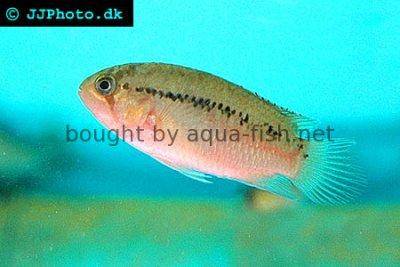Zebra acara - Nannacara adoketa
Scientific name: Nannacara adoketa
Common name: Zebra acara
Family: Cichlidae
Usual size in fish tanks: 7 - 10 cm (2.76 - 3.94 inch)
014
Recommended pH range: 5.8 - 6.6
Recommended water hardness: 2 - 7°N (35.71 - 125ppm)
0°C 32°F30°C 86°F
Recommended temperature range: 24 - 27 °C (75.2 - 80.6°F)
The way how these fish reproduce: Spawning
Where the species comes from: South America
Temperament to its own species: peaceful
Temperament toward other fish species: peaceful
Usual place in the tank: Bottom levels
Short description
The Zebra acara (Nannacara adoketa; often listed today as Ivanacara adoketa) is a striking blackwater dwarf cichlid from Brazil’s Rio Negro system. It shows bold vertical barring with metallic highlights, a high-contrast head mask, and pronounced fin extensions in males. Generally peaceful in a well-chosen community, but territorial during courtship and spawning. Best color and behavior appear in soft, acidic water with leaf litter and dim light.
Origin
South America – upper Rio Negro basin (Brazil) in slow, tannin-stained blackwater streams, flooded forest margins, and igarapés with sandy bottoms, wood, and leaf litter. Water is typically very soft and acidic with low conductivity.
Food and feeding
A small-mouthed micro-predator/omnivore. Provide a staple of high-quality micro-pellets or fine flakes and frequent small portions of frozen/live foods (e.g., baby brine shrimp, daphnia, cyclops, blackworms). Rotate in spirulina-rich foods or blanched greens occasionally for gut health. Offer small feedings 2× daily to match their foraging style and keep water pristine.
Sexing
Males are larger, with more elongated dorsal/anal fins and stronger facial patterning; females remain smaller, rounder when ripe, and often show a warmer gold/rose wash in breeding dress. External differences are subtle in juveniles; behavior near shelters is often the best clue.
Breeding
A cave/substrate spawner. Provide snug caves (ceramic tubes, half-coconut, rock crevices) and leaf litter. The female tends eggs and early fry in the cave; the male defends the territory. At 25–26 °C, eggs typically hatch in ~2–3 days; fry become free-swimming in ~4–6 days. Start with infusoria/rotifers or powdered fry foods, then transition to newly hatched brine shrimp. Keep flow gentle, oxygen high, and water extremely clean.
Lifespan
Typically 5–8 years with excellent husbandry.
Behavior & compatibility
Generally peaceful to non-aggressive tank mates of similar size that enjoy soft, warm water (small tetras, pencils, Corydoras suited to warm temps). However, pairs are territorial—especially toward conspecifics and similarly shaped dwarf cichlids. Keep as a bonded pair or one male with one female in a well-structured layout.
Tank requirements
- Tank size: ~70–100 L for a pair; larger if housing additional peaceful companions.
- Aquascape: fine sand, leaf litter, tangled roots/wood, and multiple snug caves; subdued lighting (floating plants help).
- Water: very soft, acidic water preferred (your pH 5.8–6.6, GH 2–7 °dH are appropriate). Temperature 24–27 °C is a practical sweet spot.
- Filtration: gentle flow, strong biofiltration; maintain low nitrate with regular small water changes.
Care notes
This species shows its best color and calmest behavior in blackwater conditions (tannins, humic acids). Stability matters more than chasing exact numbers; avoid abrupt parameter swings.
Taxonomic note
The species is widely referred to in the hobby as Ivanacara adoketa following a later generic placement; many resources still list it under Nannacara. Husbandry is the same.
Pictures
Bought by aqua-fish.net from jjphoto.dk.




 Thread-finned
Thread-finned  Acara
Acara  Yellow
Yellow  Patrick's
Patrick's  Blue
Blue  Green
Green  Acara
Acara  White
White  Compressed
Compressed  Pastel
Pastel  Midas
Midas  Red
Red  Bluemouth
Bluemouth  False
False  African
African  Agassiz's
Agassiz's  Banded
Banded  Yellow
Yellow  Cockatoo
Cockatoo  Blue
Blue  Blackstripe
Blackstripe  Highfin
Highfin  Redstripe
Redstripe  Threadfinned
Threadfinned  Macmaster’s
Macmaster’s  Panda
Panda  Norbert’s
Norbert’s  Blue
Blue  Thin-line
Thin-line  Three-striped
Three-striped  Viejita
Viejita  Flier
Flier  Archocentrus
Archocentrus  Convict
Convict  Seven
Seven  Spiny
Spiny  Oscar
Oscar  Sunshine
Sunshine  Chitande
Chitande  Firebird
Firebird  Midnight
Midnight  Lake
Lake  Sunshine
Sunshine  Aulonocara
Aulonocara  Nyasa
Nyasa  Ruby
Ruby  Grants
Grants  Aulonocranus
Aulonocranus  Chameleon
Chameleon  Benitochromis
Benitochromis  Orinoco
Orinoco  Yellow
Yellow  Brichard’s
Brichard’s  Guenther’s
Guenther’s  Southern
Southern  Cichla
Cichla  Peacock
Peacock  Chiseltooth
Chiseltooth  Bolivian
Bolivian  Red
Red  Many-pointed
Many-pointed  Jack
Jack  Red
Red  Three
Three  Keyhole
Keyhole  Azureus
Azureus  Red
Red  Jackson’s
Jackson’s  Crenicichla
Crenicichla  Honduran
Honduran  Blue-eye
Blue-eye  Afra
Afra  Frontosa
Frontosa  Slender
Slender  Malawi
Malawi  Chequerboard
Chequerboard  Checkerboard
Checkerboard  Malawi
Malawi  Ectodus
Ectodus  Tanganyika
Tanganyika  Canara
Canara  Green
Green  Rostratus
Rostratus  Pearl
Pearl  Geophagus
Geophagus  Yellowhump
Yellowhump  Suriname
Suriname  Redhump
Redhump  Red
Red  Dority’s
Dority’s  Argentine
Argentine  Burton’s
Burton’s  Victoria
Victoria  Haplochromis
Haplochromis  Jewel
Jewel  Banded
Banded  Lifalili
Lifalili  Lowland
Lowland  Texas
Texas  Pantano
Pantano  Severum
Severum  Banded
Banded  Severum
Severum  Rainbow
Rainbow  Parrot
Parrot  Chocolate
Chocolate  Brown
Brown  Marlieri
Marlieri  Golden
Golden  Striped
Striped  Masked
Masked  Konye
Konye  Blue
Blue  Trewavas
Trewavas  Electric
Electric  Dwarf
Dwarf  Redbreast
Redbreast  Lamprologus
Lamprologus  Gold
Gold  Greenface
Greenface  Mayan
Mayan  Aurora
Aurora  Blue
Blue  William’s
William’s  Zebra
Zebra  Malawi
Malawi  Blue
Blue  Blue
Blue  Mbuna
Mbuna  Parallel
Parallel  Purple
Purple  Flag
Flag  Bolivian
Bolivian  Ram
Ram  Basket
Basket  Haitian
Haitian  Striped
Striped  Neolamprologus
Neolamprologus  Brevis
Brevis  Fairy
Fairy  Neolamprologus
Neolamprologus  Cylindricus
Cylindricus  Hecq’s
Hecq’s  Neolamprologus
Neolamprologus  Lemon
Lemon  Mustax
Mustax  Daffodil
Daffodil  Six-bar
Six-bar  Five-bar
Five-bar  Marbled
Marbled  Giraffe
Giraffe  Blue
Blue  Sulphurhead
Sulphurhead  Wolf
Wolf  Jaguar
Jaguar  Blue
Blue  Marakeli
Marakeli  Madagascar
Madagascar  Pinstripe
Pinstripe  Pelmatochromis
Pelmatochromis  Kribensis
Kribensis  Striped
Striped  Red
Red  Deepwater
Deepwater  Fenestratus
Fenestratus  Nichols’
Nichols’  Southern
Southern  Bumble
Bumble  Demason’s
Demason’s  Slender
Slender  Red
Red  Mbuna
Mbuna  Malawi
Malawi  Kenyi
Kenyi  Powder
Powder  Altum
Altum  Angelfish
Angelfish  Angelfish
Angelfish  East
East  Juba
Juba  Earth
Earth  Electric
Electric  Azure
Azure  Lionhead
Lionhead  Discus
Discus  Blue
Blue  Red
Red  Zebra
Zebra  Brichard’s
Brichard’s  Blue
Blue  Firemouth
Firemouth  Zebra
Zebra  Yellow
Yellow  Blue
Blue  Dwarf
Dwarf  Blunthead
Blunthead  The
The  White
White  Twoband
Twoband  Fenestratus
Fenestratus  Window
Window  Tailbar
Tailbar  Black
Black  Redhead
Redhead  Oaxaca
Oaxaca  Xenotilapia
Xenotilapia